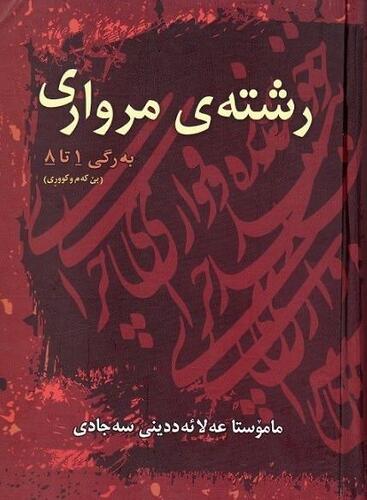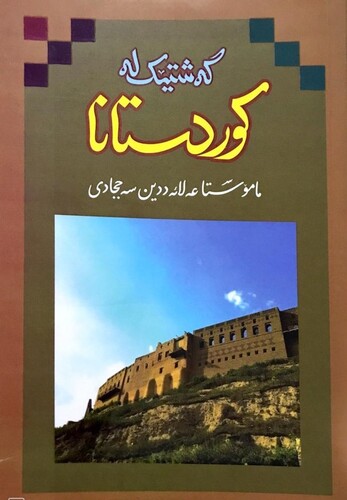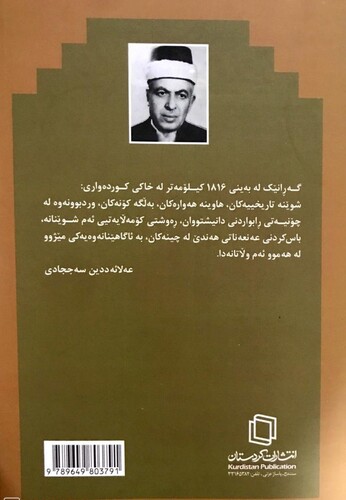Alaeddin Sajjadi is a well-known name in Kurdish writing and literature history. He is one of the intellectuals who moved from the East part of Kurdistan to the South part of Kurdistan and remained there until the last moments of his life. He was born in 1907 in the Qatarchian neighborhood of Sna (Sanandaj); then he started studying. After completing basic books in the East part of Kurdistan, he came to Sulaimani in 1923 and became a jurist in the mosque of Haji Mullah Rasul Delezha. In 1938, he completed his religious studies. Then, like all well-educated scholars, Sajjadi moved to Baghdad, Iraq's largest city and metropolis. There, he began his cultural work. He worked with Brayim Ahmad for a while in Galawezh magazine. He later became a lecturer in literature and history of Kurdish literature at the College of Arts of Baghdad University, and then became an active member of the Kurds' Information Association. His last administrative position is the Secretary General of Endowments, which is a minister. He worked in this position in Erbil until his last year of retirement. Sajjadi did a lot of research and writing in the field of Kurdish literature and history and finally passed away in 1984 in Baghdad.
Some of his books include; The Pearl Chain, The History of Kurdish Literature, The Texts of Kurdish Literature, The History of Kurdish Uprising, The Living Universe, The History of Kurdish Poem, and A Journey in Kurdistan.


His most famous books are The History of Kurdish Literature and The Pearl Chain. However, a less talked about book is A Journey in Kurdistan. In this article, I want to write about it.
Travelogue has been one of the forms of writing that travelogue authors have written about their experiences for various purposes since ancient times. For instance, among the Persians, the travelogue of the great Iranian poet Naser Khosrow Ghobadiani is a travelogue that captures Naser Khosrow's personal experiences. He thereby gives his readers his knowledge of the geography of fifth-century Muslim countries. The travelogue of Pietro Della Valle, who visited Iran during the Safavid period, explains many issues and informs the reader about some political situations of Kurdistan in the Safavid period. Through this travelogue, he separates the differences between different regions of Kurdistan, such as Kermashan, Garous, and Ardalan. Writing travelogues in the form of poems was not common among the Kurds. In 1955, however, Alaeddin Sajjadi wrote his travelogue during a trip to Kurdistan entitled "A Travel in Kurdistan".

What is remarkable about Alaeddin Sajjadi's book is that the reader sees the views of a well-known personality and a talented writer on different parts of Kurdistan and the places he traveled to. Although the period in which Alaeddin Sajjadi traveled is not very long ago, the book is important in several ways: it explains some of the natural and social conditions of the 1950s in the Southern part of Kurdistan. Sajjadi, meanwhile, begins his journey in Mosul and describes the social structure of Mosul. That is, what Sajjadi sees in Mosul, the Arab and Kurdish composition of the city, is important for the present and the current political and social understanding. More than half a century ago, Sajjadi mentioned that Mosul was predominantly Arab in addition to Kurdish, but Sajjadi emphasizes that the entire surrounding areas like villages were Kurdish. Kurdish politicians need to know how far around Mosul falls within the geography of the Kurdistan Region.
As an educated person, Sajjadi describes the literacy of different parts of Kurdistan at that time. In Mosul, for example, he talks about some points that are interesting at the time. He mentions how many public libraries are in Mosul. How many books were there in those libraries? He wanted to know whether Kurdish books were available in libraries in the city, which also has an Arab and Kurdish community, and what the level of book borrow was in Mosul in 1955. How many books are lent to people daily? How many people were reading books in the Mosul library?

What are the most important, touristic, and cultural places in Mosul are. After Mosul, he goes to Kurdish cities such as Akre and Zakho, Sajjadi's view and comparison between an Arab city such as Mosul and other Kurdish cities is again important for the reader. He explains what the situation was like in Kurdish cities and an important Arab city like Mosul at that time. It provides some information that is useful to historians and sociologists, in terms of civil services and municipal affairs, and terms of development.
In this book, Alaeddin Sajjadi tried to write everything that he saw very precisely. He has recorded the most detailed stories and events that have come along the way and mentioned them in the introduction. He says: This is important for those, in the future, who want to know what happened in the Kurdish regions and Kurdistan's geography. However, the language Sajjadi has chosen is not very rich. He wrote in a simple language and even his language is not very regular, but his travel is a scheduled one. He wrote the population and area of each city he saw in the manner of old travel writers. He wrote the house numbers. He wrote the distances of the cities from each other. All these will be important in the future and they still have several characteristics for the Kurdish reader:

One of its characteristics is that although its language is not very literary and fluent, it is concise and correct. It is a simple language that everyone understands. On the other hand, the reader takes a month-long trip to Kurdistan with Sajjadi and gets to know different cities of Kurdistan. He knows the relationships of a Kurdish scholar with the state institutions at that time. Because Alaeddin Sajjadi was a well-known person in every city he went to, he had contacts with state institutions and administrators, and through this, the reader gets some clues about the role and position of Kurds in state institutions at that time. What was Sajjadi's relationship with poets, writers, and intellectuals of the time, such as Shakir Fatah? All these characteristics give us a concise book and the reader can take a month's journey through Kurdistan and go back half a century to the past of Kurdistan and see different cities of Kurdistan through the views and camera of Alaeddin Sajjadi.










